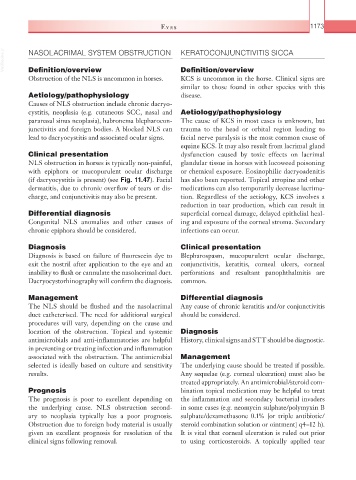Page 1198 - Equine Clinical Medicine, Surgery and Reproduction, 2nd Edition
P. 1198
Eyes 1173
VetBooks.ir NASOLACRIMAL SYSTEM OBSTRUCTION KERATOCONJUNCTIVITIS SICCA
Definition/overview
KCS is uncommon in the horse. Clinical signs are
Obstruction of the NLS is uncommon in horses. Definition/overview
similar to those found in other species with this
Aetiology/pathophysiology disease.
Causes of NLS obstruction include chronic dacryo-
cystitis, neoplasia (e.g. cutaneous SCC, nasal and Aetiology/pathophysiology
paranasal sinus neoplasia), habronema blepharocon- The cause of KCS in most cases is unknown, but
junctivitis and foreign bodies. A blocked NLS can trauma to the head or orbital region leading to
lead to dacryocystitis and associated ocular signs. facial nerve paralysis is the most common cause of
equine KCS. It may also result from lacrimal gland
Clinical presentation dysfunction caused by toxic effects on lacrimal
NLS obstruction in horses is typically non-painful, glandular tissue in horses with locoweed poisoning
with epiphora or mucopurulent ocular discharge or chemical exposure. Eosinophilic dacryoadenitis
(if dacryocystitis is present) (see Fig. 11.47). Facial has also been reported. Topical atropine and other
dermatitis, due to chronic overflow of tears or dis- medications can also temporarily decrease lacrima-
charge, and conjunctivitis may also be present. tion. Regardless of the aetiology, KCS involves a
reduction in tear production, which can result in
Differential diagnosis superficial corneal damage, delayed epithelial heal-
Congenital NLS anomalies and other causes of ing and exposure of the corneal stroma. Secondary
chronic epiphora should be considered. infections can occur.
Diagnosis Clinical presentation
Diagnosis is based on failure of fluorescein dye to Blepharospasm, mucopurulent ocular discharge,
exit the nostril after application to the eye and an conjunctivitis, keratitis, corneal ulcers, corneal
inability to flush or cannulate the nasolacrimal duct. perforations and resultant panophthalmitis are
Dacryocystorhinography will confirm the diagnosis. common.
Management Differential diagnosis
The NLS should be flushed and the nasolacrimal Any cause of chronic keratitis and/or conjunctivitis
duct catheterised. The need for additional surgical should be considered.
procedures will vary, depending on the cause and
location of the obstruction. Topical and systemic Diagnosis
antimicrobials and anti-inflammatories are helpful History, clinical signs and STT should be diagnostic.
in preventing or treating infection and inflammation
associated with the obstruction. The antimicrobial Management
selected is ideally based on culture and sensitivity The underlying cause should be treated if possible.
results. Any sequelae (e.g. corneal ulceration) must also be
treated appropriately. An antimicrobial/steroid com-
Prognosis bination topical medication may be helpful to treat
The prognosis is poor to excellent depending on the inflammation and secondary bacterial invaders
the underlying cause. NLS obstruction second- in some cases (e.g. neomycin sulphate/polymyxin B
ary to neoplasia typically has a poor prognosis. sulphate/dexamethasone 0.1% [or triple antibiotic/
Obstruction due to foreign body material is usually steroid combination solution or ointment] q4–12 h).
given an excellent prognosis for resolution of the It is vital that corneal ulceration is ruled out prior
clinical signs following removal. to using corticosteroids. A topically applied tear

